| 1900 Opal found late in the year by Jack Murray, boundary rider on Dunumbral Run, Bundinbarrina Station. He got fired from his job for digging up the land rather than looking after it! |
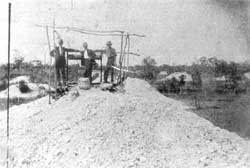 9 Mile Boundary Store 1910 |
| 1901 First registered miner, Jack Murray, was reported by Mr.Andrews, Inspector of Mines in his 1902 report. Other early miners on the field were Nat Hennessey, Peter Ferguson, Ted Bishop, and the Canfell Brothers - Tom, Mick, and Jim. |
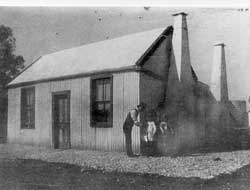 Brady's House 1910 |
| 1902 Late that year, Charlie Nettleton, the first professional prospector with experience on the goldfields and at White Cliffs, began to sink a shaft at McDonald's 6-Mile, then on Angledool Station. Joe Beckett of Weetalibah Hotel, northend of the Walgett to Angledool road, and a syndicate of businessmen sponsored his efforts. Interestingly, the Manager of Angledool Station wasn't part of it. Apparently, back in the 1880s, opal specimens he had sent to Sydney were returned as valueless. |
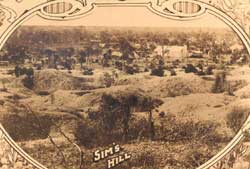 Earliest Settlement, Wallangulla 1906 |
| 1903 Nettleton's Shaft proved to be a duffer, and he mined over on Dunumbral Run near Murray. After a parcel of opal was returned to the syndicate from Sydney due to the paltry offer, the two miners teamed up. Later in the year, they walked a parcel of black opal to White Cliffs, where the market was based on light opal. This unusual nodular dark opal brought but a pittance from E F Murphy, who was willing to take the risk, promising a supplement to follow with the approval of his principal. Tullie Wollaston in Adelaide was enthusiastic. He deserves the credit for developing the world market for black opal. The first mineral lease applied for in Walgett was 22 1/2 acres near Angledool village. |
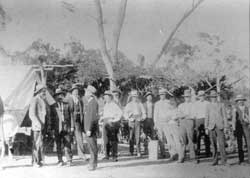 Aussie Adventurer, Ion Idriess 1910 |
| 1905 The first opal rush on Sims Hill named Ted Bishop "Opal King". He took his parcel to Sydney, prompted by a suspicious sale of one big stone in Angledool village. The Western Lands Minister of Mines was amazed at the good quality, in view of former information. Bishop sold his other big opal in Adelaide and made up his losses! |
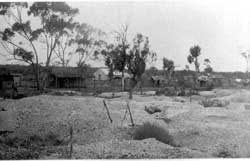 2nd settlement, Nettletonon 3-Mile Flat 1908 |
| 1906 Wallangulla settlement began forming near the Wallangilla Tank, the closest waterhole on Dunumbral Run. Tenders were called for the sinking of a government tank for the fluctuating community as the farmers weren't cooperative with letting miners use their tanks. Hammond Hill at the Grawin discovered. The first Council of Walgett Shire formed. |
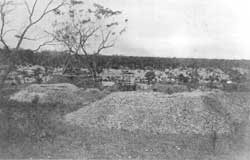 Lunatic Hill, looking to Nettleton 1908 |
| 1907 New Town and the Cemetery were surveyed on land least likely to be opal bearing. Hence Wallangulla, where the school and post office had already opened, became known as Old Town. Tanksinker Fred Dowdle was working. His family is still represented in the town. E F Murphy, opalbuyer, relocated to Old Town from White Cliffs. |
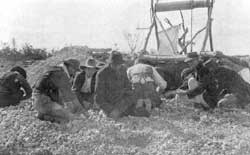 Noodlers 1908 |
| 1908 Nettleton or 3-Mile Flat settlement sprang up in a gully just three miles west of Sims Hill, when a new rush broke out nearby, on the same long ridge. The government tank didn't get quite finished, but it soon rained and filled. The Great Opal Robbery caused a stir. A local was convicted, based on the witness Ernie Smith, mail contractor. His son and namesake "Sonny" of Walgett will be 90 next year. The George Brown family arrived - grandson Bob Molyneux is still resident. The Dominick Brothers cycled from White Cliffs - two grandchildren still here. Charlie Dunstan found two huge opals, "Fire Queen" and "Queen of the Earth", at Angledool diggings. The railhead was completed to Walgett. |
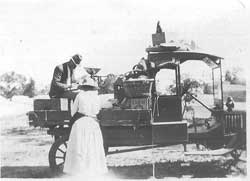 A hawker |
| 1909 In its heyday, probably 1200 people, mostly single men, lived on the 3 Mile, an independent community to Old Town. Ion Idriess, miner and well known author, describes the situation in his "Lightning Ridge", published 1940. The first accommodation, the Imperial Hotel, opened December 1909 in the New Town, when Bradys, opalbuyers from White Cliffs, also moved into their home (Walford's today, up from Festival IGA today). The Bruce family arrived on the opalfields from Cobar, as did the ABJ "Pappa" Francis family - some grandchildren are still here! Pappa, as well as Ernie Sherman, both Cliffs' opalbuyers, relocated, as production there fell. Mrs ABJ "Kitty" Francis was the only lady opalbuyer, as reported in the Walgett Spectator. The Vice Regal, Sir Harry Rawson, and his daughter visited Walgett and the Ridge. The Kite Brothers, Temora, came north shearing, later settling permanently at the 9 Mile. |
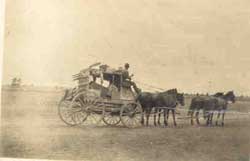 Smith's Coach & Mail 1906 |
| 1910 Population on the Wallangulla Opalfields was larger than Walgett. A call by the miners for permanent water - a bore - to be sunk, fell on deaf ears! First Billiardroom opened across from the Hotel in Morilla Street (where Shell is). Charlie Dunstan was the first reported suicide. A post office agency was established at 3 Mile Flat, and the first New Town post office opened in November, Morilla Street. The first girl baby in the main street was christened Morilla, "Milly" Canfell, by her father Mick. A tender went out for a school at New Town. Mick Donnelly built a nice house - burnt down in Opal Street 1993. Dances were held in Martin's Hall (behind where Terry Barclay lives today). |
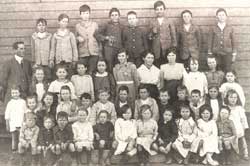 Class of 1916 |
| 1911 Walgett Spectator reports the rumor: "...the ridge near Kookran Lake carrying good opal..." - 9 Mile. Continued push for a bore by local Member, A. Black. First Census held. Telegraph line laid to New Town. The butchery across from the pub (later part of Dawson's home) had probably been built originally by Jack Prentice, who drew "Wellwood" on the Walgett Road. Possibly Jack Donnelly took his father's Old Town butchery business to this location. Inaugural Race Meeting in September. Schoolmaster at 3 Mile Flat. |
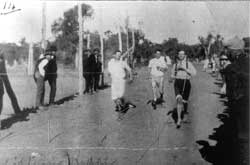 Foot race |
| 1912 Government called for closer settlement and relocation into the New Town. No further commercial leases were granted at the field settlements. Urwin and McDonald built a school in New Town for the consolidation. Businesses began relocating. St.George's Anglican Church was built, probably by Tom Urwin. He built a house for his bride Min (Michael's Nursery today). Regan's Store specializing in cordial and sweeties was operating (next to Black Opal Motel). |
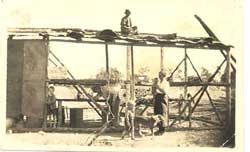 9 Mile Boundary Store 1910 |
| 1913 The Cottage Hospital formation committee chose three sites. Mandy Khan, formerly an Old Town shopkeeper, opened a branch to his Cumborah shop in Morilla Street (Bluey's Motel site). |
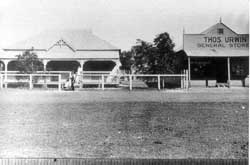 Store & Police Station, ca.1910 |
| 1914 Bush Nurse Association was established and the first nurse arrived and lived at the Hotel. The Cottage Hospital had been built with volunteer labor as directed by Urwin and McDonald (relocated to behind Spicer's Hut in Morilla Street 1999). WWI drew miners into service. "Flame Queen" was mined on Bald Hill not far from Dunstan's Angledool diggings. Second Post Office built by Tom Urwin in Morilla Street (demolished 1992). |
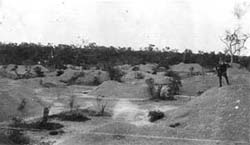 1920's opal fields |
| 1915 Urwin built a general store for Nygah, formerly a hawker, then shopkeeper at Cumborah. Alongside, he built the first police station (the Bruce house today) across from the police paddock. Tom Urwin and Snowy Brown mined "Empress of Australia" (dropped and broken), "Black Prince","Flamingo" and "Pride of Australia" at Phone Line. (In 1920, Ernie Sherman paid 2000 pounds for these stones - the highest price ever paid for four black opals!) Reeves General Store operated beside the Imperial Hotel, previously Dick Howe's bakery (his widow married Bert Beckett in 1926). |
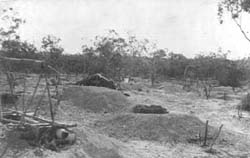 1920's opal fields |
| 1916 Generally, quiet during WWI on the opalfields. Cooper's Cottage (today) built by Ben Buren, a Swede. Fred Bodel's hut on 3 Mile Flat was built by German Bros. |
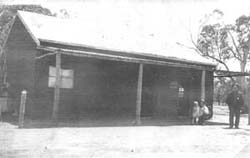 1920's business house |
| 1918 Tom Urwin took over Nygah's general store as Urwin's Store, next to the police station. The family lived in the back. Urwin and McDonald built the Hall across from the Imperial (where the Black Opal Motel is today). Bert Becket, son of Joe, took over the Tysons Tank (sunk by the goverment in 1885), below the Six Mile field and on the stockroute. Donnellys had been there until they drew a block near Dirrinbandi (Grace Molloy, formerly Angledool and lately Walgett, is a daughter, Lorraine a grandaughter). George Becket fell in WWI and his youngest brother, Reg's, widow and daughter Lyn are known to us. |
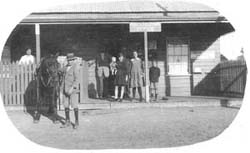 Second Post Office 1920's |
| 1920 Dungaleer's Gooraway Hotel on the Walgett road ceased to operate. Jack Dominick took up Lorne Station. "Butterfly" diggings was the new rush, probably due to the origin of the stone bearing that name, and one given pride of place by buyer Ted Murphy, the best judge of opal at the time. Dick Huggard (Kitty Francis' brother) built a second billiardroom, where Boardman's Arcade is. Richards Hill at the Grawin was discovered. Elizabeth Brown alias Mrs Wilby Wilby was shot dead at the Grawin Creek Inn, delicensed for some years. No one was convicted… |
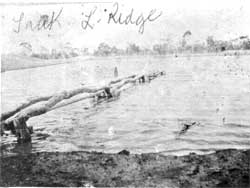 Dooly - natural creek of the Ridge |
| 1921-1925 Albert Dominick became postmaster. There were three telephone subscribers. Bert Brown and his large family came to town, the men as contractors (fencing, ringbarking, etc.) rather than miners, initially. An airplane landed in Morilla Street! Roy Allport built his matrimonial home 1924 (Noel Kennedy's today), then built his widowed mother-in-law a house next door in the 1930s, where Bob Molyneux lives today. |
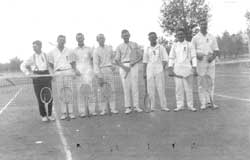 Tennis Tennis |
| 1926-1928 The delicensed Weetalibah Hotel burned, Constable George Cox Sr inspecting the matter - his grandchildren are here. A small exodus to the opal rush southwest, where the "Grawin Queen" caused a sensation. Regan's Store relocated, even offering a small library courtesy of Dymocks! The little community of the Grawin came the closest ever to being declared a village. "Sunset Queen" was broken into chips but was suspected to have been 9-10 oz., a massive opal. "Light of the World" from the Grawin was larger than "Pandora", which was found towards Bald Hill earlier the same year, 1928. |
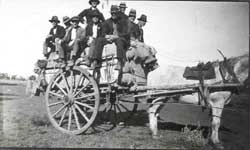 Shearer's going to "Bangate" 1921 |
| 1927 Imperial Hotel burned down, a colorful spectacle as the spirits "went up"! Suspicions confirmed… |
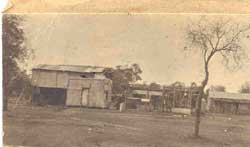 Home in town, today's Kaolin Street |
| 1929 Petition lodged to reserve parklands (caravan park, sports complex, pool today). Imperial Hotel rebuilt. |
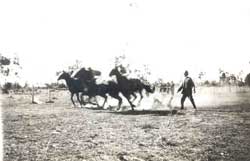 Start of Black Opal Bracelet 1922 |
| 1930s The government paid a shilling per foot to sink shafts during the Depression. Bruces operated a general store in Morilla Street, about where St. Vincent de Pauls is today. They delivered on the field. |
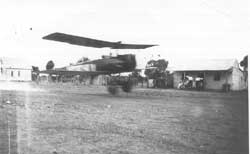 Plane Land in Morilla street 1921 |
| 1932 Third post office built by Jim Alderslade (Ridge Cafe today). Ray Hinds was postmaster. Spicer's or Graham Bros Cottage built by Bert Spicer when he struck opal with Laurie Hart, hence Harts & Spicers field of today. |
|
| 1933 The Anglican Church was blown to a leaning position and propped up for a time: "Well supported Church in L/Ridge" headlined one Sydney article! Lord and Lady Game visit the Ridge. Five telephone subscribers. |
|
| 1937 Second St George's Anglican Church replaces the condemned structure, built by Roy Allport/Jim Denis/Jack Boules (relocated as St George's Serbian Orthodox Church 1998) . Bert Spicer sold his cottage to the Graham Bros and moved to Parkes, where his son Mal still resides. Jack & Mary Francis married and took over the third post office/shop across from the Imperial Hotel. Mick Canfell returned and bought the old second post office from Albert Dominick, continuing to operate the general store within. The added butcherstand (1934) to the east of it was leased out for about ten years. Both were demolished in 1992. |
|
| 1940s WWII drew miners into service and the opalfields were quiet. The police station closed in 1944. The Cottage Hospital struggled to keep going on community funds. Population dwindled to fifty children at the school. Bert Cooper and family arrived 1943. The Artie Dawsons moved in from Llanillo Station about 1946, and he took over Reeves Store next to the Imperial, opening a butchery next door towards the hotel. He delivered groceries on the field. Late that decade, Jack Francis soldup and went to his property. Les Wharton took over the third post office/general store. |
|
| 1950s Bob Molyneux returned from Coober Pedy with his family. Full-time telephone service. Big floods! Orme Long, grandfather of the Molyneux boys, developed the first dry rumbler. The Mud Hut was built by Leechman. Harold Hodges came to the Ridge. The first trams arrived. The old hall (where the Black Opal Motel stands) blew down in a mini-cyclone. Dick Brown's Cafe (where Riteway is today) opened late in the decade. |
|
| 1960s The Tree of Knowledge got too scanty and was pulled down at the main intersection. Dawsons moved across the street into the third post office/general store, living alongside. A syndicate of graziers sank Llanillo Bore 2, today's mineral baths. The police station reopened. Roger Climpson came to town! The airstrip was surveyed, not to be surfaced for thirty years. Electricity arrived.The Bowling Club started about the time the Imperial Hotel was renamed the Diggers Rest. The first motel complex, Tram-o-tel, in operation. Eric Catterall developed the automatic hoist. Permanent water inspired wet puddling. The Walk-in Mine opened as the first tourist attraction, then Tex Moerkel's Bottle House at Opal Village. The Governor of NSW, Northcott, then the Governor General, Lord Casey, visited Walgett Shire. The Flash newspaper began late 1969, and there, recent history is recorded - or at least what you old timers may have filed away in recollections of a fast-changing community! |
|
| 1976
The Pistol club was formed in 1976 by 20 keen locals. The club house was "Ridge' style pole and corrugated iron and the one range had manually turning target frames timed with a stopwatch. |
|
| 2001 (30 June) Lions Club Folds after 18 Years. Chartered in July 1983 Lightning Ridge Lions Club has hung up it's banner as the club was no longer a viable committee. See the Lions old website for their achievements. |

